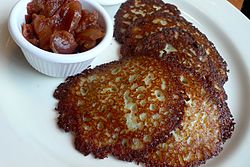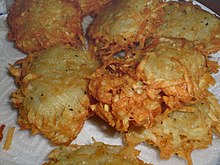Latke
Latkes (לאַטקע, sometimes spelled latka) are a type of potato pancake of Ashkenazi Jewish origin that are traditionally prepared to celebrate Hanukkah.[1]
 | |
| Alternative names | Levivot, latka, potato pancake |
|---|---|
| Type | Ashkenazi Jewish cuisine |
| Region or state | Central and Eastern Europe |
| Created by | Ashkenazi Jewish community |
| Serving temperature | Hot, traditionally with sour cream or applesauce |
| Main ingredients | Potatoes, onion, egg, matzo meal, kosher salt, cooking oil |
Etymology
The word latke is derived (via Yiddish) from the East Slavic word oladka, a diminutive from oladya, "small pancake".[2][3] The Slavic word derives from Ancient Greek ἐλάδιον, diminutive of ἔλαιον, "olive oil", "oily substance".[2][3][4]
The word levivah (לביבה), the Hebrew name for latke, refers in the Book of Samuel to a dumpling made from kneaded dough, as part of the story of Amnon and Tamar.[5] Some interpreters have noted that the homonym levav (לבב) means "heart," and the verbal form of l-v-v occurs in the Song of Songs as well. In the lexicon of Ashkenazi Jews from Udmurtia and Tatarstan there are recorded versions of the kosher-style appellation of latkes during the eight-day Hanukkah holiday.[6]
History
First variants of latkes go back to at least the Middle Ages.[2] They were probably made of cheese (probably either ricotta or curd cheese), fried in poppyseed oil or butter, served with fruit preserves, and these cheese latkes were the most common kind of latke in Ashkenazi communities until the 19th century (when the potato arrived in eastern Europe).[2][3][7][8] However, at the time, the cheapest and most readily available cooking fat was schmaltz, rendered poultry fat (usually from a goose or chicken), and due to Jewish dietary laws, which prohibit the mixing of meat and dairy products, alternatives to the cheese latke arrived. These included buckwheat or rye flour, or other tubers endemic to the region, such as turnips.[9] However, once the potato became popularized in eastern Europe, it was quickly included as a latke ingredient and became so popular that today, the word latke is almost synonymous with potatoes.[2]
Variations
Latkes today are traditionally made with potatoes, although other vegetables are also sometimes used, albeit less frequently. Potato remains the most popular variety of latke. There are two main varieties of potato latkes, those made with grated potato and those made with puréed or mashed potato. The textures of these two varieties are very different.
Grated potato version

Latkes made of grated potatoes are the most traditional version and are still very popular. They are prepared by grating potatoes and onions with a box grater or food processor, and excess moisture is squeezed out. Eggs and flour or matzo meal are then mixed with the potatoes, and the latkes are fried in batches in an oiled pan. The thickness depends on personal preference.
Puréed potato version
This version of latke is made with pureed potatoes. As with the aforementioned grated potato version, potatoes and onions are grated, and are added to egg and matzo meal. But in this version the ingredients are then processed in a food processor until a pureed consistency is attained. This form of latke is easier to shape, and according to Jewish chef Jamie Geller, they have a “pudding-like consistency.”[10]
Other variations
Latkes need not necessarily be made from potatoes. Prior to the introduction of the potato to the Old World, latkes were and in some places still are, made from a variety of other vegetables, cheeses, legumes, or starches, depending on the available local ingredients and foods of the various places where Jews lived.[11] Numerous modern recipes call for the addition of ingredients such as onions and carrots.[12][13] Daily variations on a simple potato latka might include zucchini, sweet onion and gruyere (for french onion flavor) and some variations made with sweet potatoes.[14]
In popular culture
Latkes are a traditional food consumed by Ashkenazi Jews during Hanukkah, and have featured prominently in Jewish, Israeli and general American culture.
- Latke, the Lucky Dog is a 2012 children’s book about Hanukkah that features latkes and a dog named after the iconic Jewish food.
- In the film Eight Crazy Nights (an American Hannukah film by Adam Sandler), latkes are featured prominently and can be seen in various scenes; they are eaten by several characters in the film.
- The novel American Psycho mentions latkes briefly in a scene where protagonist Patrick Bateman is mockingly offered some by his colleague Preston.
- In the film The Hebrew Hammer, the title character is seen eating latkes and makes a number of latke-related puns.
References
- Koenig, Leah (2015-03-17). Modern Jewish Cooking: Recipes & Customs for Today's Kitchen. Chronicle Books. p. 119. ISBN 9781452132327. Retrieved 22 December 2015.
- Marks, Gil (2010-11-17). "Latke". Encyclopedia of Jewish Food. Houghton Mifflin Harcourt. p. 707. ISBN 978-0544186316. Retrieved 22 December 2015.
- Goodman, Matthew (2001-11-23). "On Chanukah, Cheese Was the Norm, But Then Came the Potato". Forward. Archived from the original on 2005-09-07. Retrieved 2017-05-30.
- Vasmer, Maksimilian Romanovich (1973) [1958]. Etimologichesky slovar russkogo yazyka (Этимологический словарь русского языка) [Russian Etymological Dictionary] (in Russian). Moskva: Progress.
- DLC (2006-12-18). "Analysis of the word "latke"". Balashon. Retrieved 2011-12-25.
- Altyntsev A.V., "The Concept of Love in Ashkenazim of Udmurtia and Tatarstan", Nauka Udmurtii. 2013. № 4 (66), p. 131. (Алтынцев А.В., "Чувство любви в понимании евреев-ашкенази Удмуртии и Татарстана". Наука Удмуртии. 2013. №4. С. 131: Комментарии.) (in Russian)
- Wex, Michael (2016-04-12). Rhapsody in Schmaltz: Yiddish Food and Why We Can't Stop Eating It. St. Martin's Press. ISBN 9781250071514.
- "Discover the History of Latkes". PBS. 12 December 2011.
- Wex, Michael (2016-04-12). Rhapsody in Schmaltz: Yiddish Food and Why We Can't Stop Eating It. St. Martin's Press. ISBN 9781250071514.
- Geller, Jamie. "Healthier Potato Kugel Recipe (Recipe for potato kugel but she talks about this kind of latke later in the video)". Youtube. Retrieved 8 October 2019.
- Appelbaum, Yoni (11 December 2015). "Everything You Know About Latkes Is Wrong". The Atlantic. Retrieved 22 December 2015.
- Rachel Ray, Quick Potato and Carrot Latkes, The Food Network, December 20, 2008.
- Philip and Karen Selwyn, Potato-carrot-onion Latkes, rec.food.cuisine.jewish archives, Oct. 11, 1998, 1:00 AM.
- "The only latke recipe video you'll ever need". JTA. 1 February 2019. Retrieved 1 February 2019.

